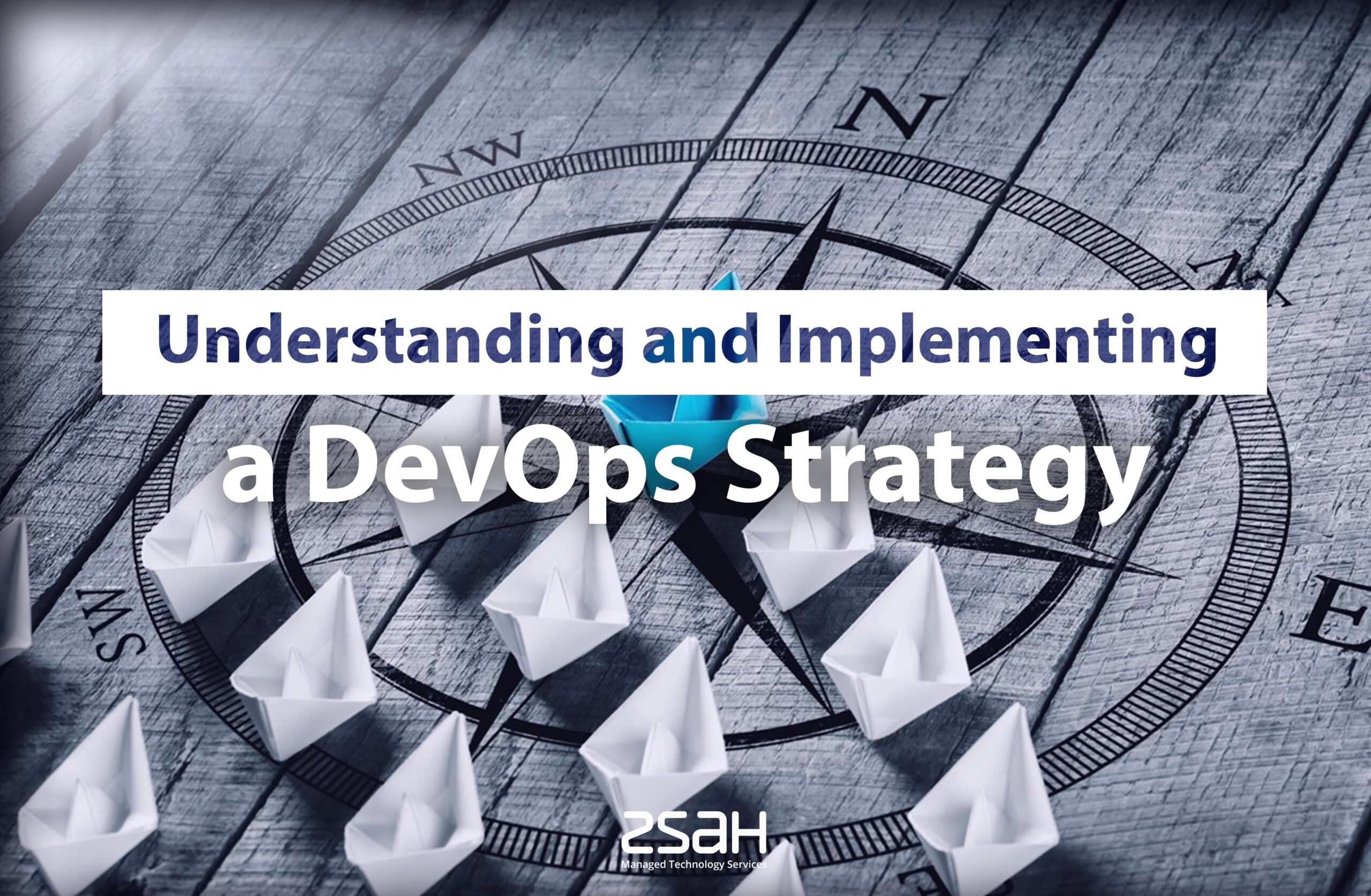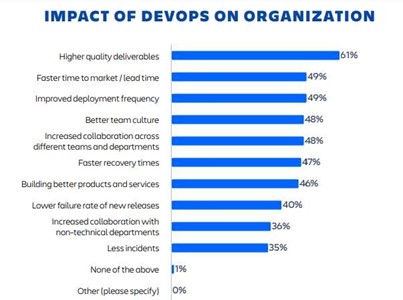Guide to Understanding DevOps and Implementing a Strategy

Numerous studies attest to the success DevOps brings to businesses. For example, a recent study by Atlassian & CITE Research that surveyed 500 professionals found the following:
- 61% said implementing DevOps helped them produce higher-quality deliverables
- 49% reported a reduction in time-to-market software and services
- 99% said DevOps had an overall positive impact on their organisation

(Image source: Atlassian & CITE Research)
A DevOps Recap
We have previously written about improving agility and staying competitive within DevOps, and scaling DevOps for success on our blog, but it is essential to do a quick recap before moving on. At its core, DevOps (a portmanteau of "development" and "operations") is a methodology for improving the collaboration between development and operations teams to streamline the software development lifecycle.
In traditional organisations, development and operations teams operate in silos. Development teams are focused on writing code and pushing features, while operations teams focus on keeping systems up and running. Unfortunately, this approach often leads to tension between the two groups, as developers sometimes feel ops are slow to deploy code changes, and ops blame developers for writing code that is not production-ready.
DevOps has emerged as a strategy to rectify these issues and introduce a whole host of new benefits to the software development process.
What Are the Benefits of DevOps?
Let's take a closer look at the benefits DevOps brings to the organisation.
- Improved collaboration between teams: One of the biggest benefits of DevOps is improved communication and collaboration between teams. DevOps promotes a culture of collaboration where teams share knowledge and work together to achieve common goals.
- Improve the performance of your software: When both development and operations are involved in the software delivery process from start to finish, there are more eyes on the codebase at every stage. This leads to improved code quality overall.
- Faster time to market: With DevOps, organisations can deploy software faster and more frequently. This is because DevOps automates and integrates the software delivery process, from writing code to deploying applications. As a result, you can quickly respond to market changes and customer demands.
- Increased efficiency and productivity: DevOps allows your team to focus on more strategic activities by automating manual tasks, such as testing, packaging, and provisioning infrastructure. Automating these processes leads to increased efficiency and productivity within your organisation.
- Greater customer satisfaction: Ultimately, getting new features to market quickly and improving the overall quality of code leads to greater customer satisfaction levels and improves the organisation's bottom line.
- Reliable infrastructure managed by code: DevOps teams manage infrastructure using code, rather than manual processes. This results in a more reliable infrastructure that is easier to scale.
- Faster problem-solving: In a DevOps environment, teams can identify and fix problems quickly. This is because they have access to more data and can use this data to troubleshoot issues more effectively. They can also gain customer feedback quicker.
How to Implement a DevOps Strategy
There’s no one-size-fits-all solution to embracing a DevOps culture, as every organisation is different. However, there are some key steps that all companies can take to get started.
Assess your current situation
The first step is to assess your current situation. Then, take a closer look at what you need and understand the patterns of the applications you want to build. Doing so will help you devise a
DevOps strategy tailored to your specific needs. You also need to set some realistic goals and objectives. What do you want to achieve? When do you want to achieve it? What are the risks and challenges involved? Once you have answers to these questions, you can create an action plan.
Devise a DevOps strategy
Before you can start reaping the benefits of DevOps, you need to devise a clear and concise DevOps strategy. The first step is to ensure that IT goals are aligned with current strategic objectives. This will help to ensure that the move to DevOps can support and further the company's overall aims. Next, the focus should be on making DevOps business-centric. This means creating a development process driven by business needs rather than technical considerations. Finally, it is important to remember that DevOps represents a massive cultural shift. As such, getting buy-in from the relevant people before setting out the strategy is essential. This will help to avoid any surprises further down the line.
Keep ultimate goals at the forefront of your strategy
Once you have devised a DevOps strategy, keeping the ultimate goals at the forefront of your mind is important. These should be the guiding principles that inform every decision made during the implementation process and continue to be tracked regularly during the project. Doing so can ensure that everyone remains focused on what is essential and that any deviations from the plan are quickly identified and rectified.
Define the process
The next step is to define the process. This includes understanding your agile development process, cloud computing needs, CI/CD workflows, automated testing and deployment process, and how you will implement continuous deployment.
Pick the right tools and technologies
There is a wide range of DevOps tools and technologies available. However, it is currently a buyer’s market as many vendors are entering this space to cater to the burgeoning need for DevOps solutions. A recent study by Allied Market Research concluded that the global DevOps market (services, solutions and tools) will grow to at least $57.9 billion by 2030, registering a CAGR of 24.2% between 2021 and 2030.

(Image source: alliedmarketresearch.com)
Each tool, technology, and vendor have strengths and weaknesses. As such, picking the right ones for your specific needs is vital. Most importantly, the tool or technology you settle on must be compatible with your IT environment.
The right tools allow you to:
- Customise your workflows
- Build a robust infrastructure
- Access controls for smooth functionality
Security and Compliance
You must integrate security and compliance into the CI/CD pipeline when implementing DevOps. Some best practices in this regard include:
- Hardening your infrastructure
- Adding a firewall to mitigate DDoS attacks
- Implementing access control policies
- Using encryption to protect data in transit
- Ensuring compliance with industry regulations
- Shifting security (Sec) left – i.e., DevSecOps
The last point is crucial. Incorporating the security review process as early as possible in the software development lifecycle creates more opportunity to address security issues sooner rather than later. When security testing is treated as an afterthought or only conducted when code is ready for production, it can be extremely difficult and time-consuming to go back and rectify problems. This can lead to delays, vulnerabilities, greater technical debt, and problematic silos between DevOps teams and security.
The solution is to bake security right into DevOps – giving us DevSecOps.
To do so, you’ll need to integrate security testing early in the development lifecycle. Consider the following:
- Static Application Security Testing (SAST)
- Dynamic Application Security Testing (DAST)
- API testing
- Dependency scanning
- Container and cluster image scanning
- Infrastructure-as-code (IAC) scanning
Integrate, measure, and deliver continuously
Finally, the last step is to integrate, measure and deliver continuously. This means making sure that all the different pieces of the DevOps puzzle fit together seamlessly. Furthermore, monitoring progress closely and making changes where necessary is important. For example, measure metrics aligned with your business goals and KPIs. These metrics will provide you with the essential data required to have visibility and control over your software development pipeline.
Common challenges in implementing DevOps
Despite the many benefits of DevOps, some common challenges can make implementation difficult. These include:
- Lack of understanding and implementation expertise: Many executives are still unaware of what DevOps is and how it can benefit their organisation.
- Resistance: Change can be difficult, and some people may resist the cultural shift that DevOps represents.
- Compatibility: As mentioned earlier, ensuring that the tools and technologies you choose are compatible with your IT environment is critical.
- Poor governance: Without proper governance, it can be challenging to maintain control over the process.
- Lack of standardisation: The lack of standardisation across tools and processes can lead to confusion and chaos.
- Manual processes: The automation of processes is a vital part of DevOps. However, manual processes can still creep in, which can hamper efficiency.
Sign Up Now!
For expert advice and resources – blogs, interviews, webinars, guides and more.
How zsah Can Help You Implement DevOps
In closing, we would be remiss if we failed to emphasise that implementing DevOps doesn't need to be an immediate switch. You can do it in phases, so it is less disruptive. The idea is to target the lowest hanging fruit first – whatever will bring the best return or improvement – and then scale your DevOps from there.
If you are looking for a partner to help you improve agility and stay competitive with your DevOps integration, zsah can help. Our team will develop optimal environments to host your applications in the cloud.
DevOps offerings also include infrastructure as code, application support, break-fix, continuous integration, and development. By utilising zsah's DevOps services, you can minimise your software development cycle, increase the efficiency and quality of software delivery, and improve your organisation's overall competitiveness. In addition, we offer 24/7/365 application support and investigatory skills in application performance and error fixing.

